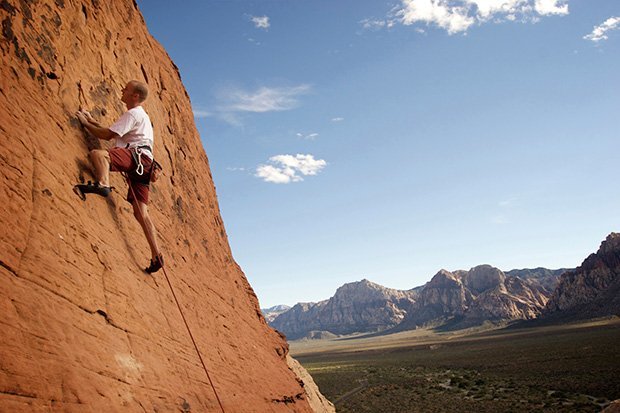Climbing Nevada’s canyons

I SHIVERED AS GUSTS of wind tumbled down the cliff face from an empty indigo-blue sky; instinctively I pulled the drawstring tighter on the hood of my lightweight jacket.
Bathed in warm sunshine when we started up the crack system, the high canyon walls quickly cut across the path of the low northern sun and a cold shadow had now crept across the varnished brown rock.
Ruefully I glanced down to my pack on the ground way below; I’d left a thick climbing top behind. “It won’t be long now anyway,” I chatted to myself. I was belaying my wife, Sabina, on the last pitch of our climb that day.
Twenty metres above me, she was poised delicately, feet stemmed across a corner on steep immaculate sandstone. “That crack looks really thin, my big fingers are going to make following this pretty hard,” I yelled fruitlessly against the wind.
Across Juniper Canyon, almost perpetually in shade, stood the imposing Rainbow Wall. The first long routes climbed in the area were – incredibly and improbably – climbed on the face of this huge chunk of red rock in 1973.
Nearby on the popular world-class 9-pitch route Crimson Chrysalis (5.8+/16+) I could just make out the silhouetted figures of climbers on the top pitch. We seemed beyond the boundaries of civilisation.
Yet a boulder-strewn dry creek wash, lined with impenetrable manzanita and oak brush, drew my eye to the sandy ochre of the desert floor and then, further east, to the shimmering outline of tall man-made structures. Buildings and spires in a row, a desert mirage of architectural shapes.
Suddenly a standard plea from a climbing leader on the “sharp end” penetrated my reverie: “Watch me!” I looked up as Sabina reached for a small opening in the crack, smeared and pressed both feet high on the wall and pulled through a crux move on The Nightcrawler (5.10c/20), four pitches of climbing high above the cacti-studded Mojave Desert.
Las Vegas is probably not the first place that springs to mind when planning an outdoor adventure trip. It’s better known for its casinos, call girls and craps tables. So it may come as a surprise that this city of about half a million people is regularly touted as one of the USA’s best places to live for outdoorsy types.
It may not have quite the hardcore adventure spirit of say, Boulder, Colorado, but it can hold its own in the world of climbing, hiking, biking and outdoor photography.
Climbing in Red Rock Canyon National Conservation Area
For other reasons we found ourselves in the United States in November, and so decided to head somewhere to work on our rusty climbing skills. During autumn in North America weather conditions limit options.
We chose Red Rock Canyon National Conservation Area, just 30km west of Vegas. With more than 2000 routes across a range of difficulties, it is arguably one of the best climbing destinations in the USA.
In addition, there are more than 15 hikes, as well as horse riding, mountain biking and road biking to pursue. In winter, nearby Mt Charleston provides for skiers and snowboarders while paddling the azure waters of Lake Mead in summer is a great way to cool off. The climbing at Red Rock caters for all types.
Short, well-protected sport routes on the rounded and colourful Calico Hills formations will appeal to those with an indoor climbing gym background while adventurous climbers, who have served their apprenticeship in the outdoors, will get a buzz from all-day outings deep in the canyons where only good route finding, technique and endurance will avoid an epic return to the car in the dark.
The enjoyable six-pitch Frogland (5.8/16) on Whiskey Peak is a great opener for multi-pitch climbing at Red Rock. The comfortable ledges on which to belay were appreciated and finishing at a summit with expansive views and an easy walk off.
The camping near Red Rock proved no match for the quality of climbing on offer, however. After two cold nights in the barren and uninteresting campsite just outside the Conservation Area we decided to cash in our chips there and opt for accommodation a little more in keeping with the themes that define Las Vegas.
The Red Rock Casino Resort is minutes away by car and a plush indoor oasis of muted, desert-toned fabrics with a health spa, restaurants, a movie theatre and even a bowling alley. Through the floor to ceiling windows in our 15th-floor room we watched the lights of the distant city emerge from the dusk.
We assuaged our guilt over retreating to such comfortable lodgings by collapsing exhausted into the elevator each evening, hungry and dirty after full days of climbing. The mystified glances we drew from fellow hotel guests were testament to their ignorance of the outdoor adventures nearby.
Climbing in Vegas
Passing dozens of early morning road cyclists on the road out to Red Rock, we made our way to the Mysterious Amphitheater in First Creek Canyon to sample the one-pitch delights of Gin Ricky (5.10c/20) and Rob Roy (5.10b/19), which gave sustained crack climbing on bulletproof grey rock.
On Power Failure (5.10b/19) at Ginger Buttress, Sabina’s route-finding skills were tested when she missed a key traverse section on easy ground and launched upward into ever more difficult terrain before an awkward retreat was undertaken.
We also ventured to the sport crags for a forearm-exploding day; there were a multitude of steep bolted climbs to choose from, with Stone and Stratocaster Walls the highlights.
Apparently Elvis was heard to say, “Man, I really like Vegas” and I like to think he visited Red Rock. Some reckon he’s not dead. If they’re right, perhaps the King is hiding out there in the canyons with the coyotes, his signature moves coming in handy for soloing the chimneys of Epinephrine.
Source: Australian Geographic Outdoor, September/October 2012
RELATED STORIES

